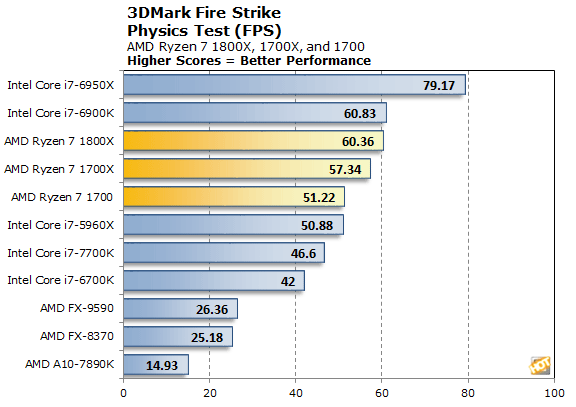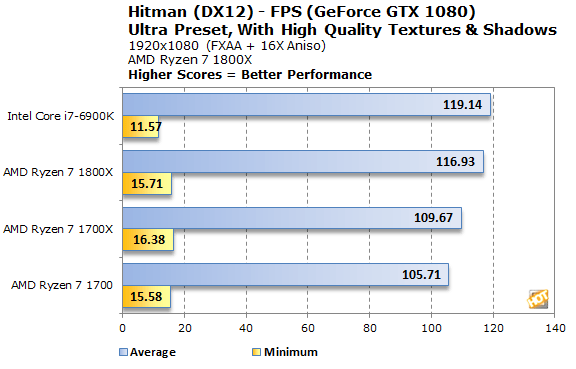AMD Ryzen Review: Ryzen 7 1800X, 1700X, And 1700 - Zen Brings The Fight Back To Intel
For our next series of tests, we moved on to some game-related metrics with Crysis and 3DMark, specifically the physics benchmark that's part of the Fire Strike test. When testing processors with Crysis, we drop the resolution to 1024x768, and reduce all of the in-game graphical options to their low preset values to isolate CPU and memory performance as much as possible. However, the in-game effects, which control the level of detail for the games' physics engines and particle systems, are left at their maximum values, since these actually do place a load on the CPU rather than GPU. For the 3DMark Physics test, we simply create a custom 3DMark run consisting solely of the physics test, which is CPU dependent, and report the results...
|


|
We also ran some high-resolution game and graphics tests on AMD's new Ryzen processors using 3DMark, Hitman, and Ashes Of The Singularity. We used 3DMark's Fire Strike Ultra preset, and both of the games were run with 4K and 1080P resolutions, with all in-game graphics options set to their maximum values for the 4K tests and "High" preset values for the 1080P tests. Note, we also swapped out the GTX 960 for a GeForce GTX 1080 here.







Things kind of went off the rails with Ashes Of The Singularity, though. We're going to get the 4K numbers out of the way first, because they don't have any surprises to explain. All of the processors were tightly grouped, though the Core i7-6900K had an overall advantage in all of the tests.

And then this happened at 1080p. The AMD Ryzen 7 processors remained tightly grouped, but the Intel Core i7-6900K stretched its legs and scampered off to a massive lead. Sometime is amiss.


The CPU focused tests in Ashes also showed similar, huge deltas.
We spent a lot of time experimenting with different settings, drives, and graphics cards trying to understand what was happening in Ashes, but never nailed down a clear answer. We tried testing the game with and without SMT, with and without Cool n' Quiet, at different memory speeds, at different power plans, and also while manually setting frequencies in multipliers. Ultimately, we could get the score to go up or down measurably, but could never get things in-line with expectations. It is possible that a combination of SenseMI’s algos not detecting some workloads properly, lackluster cache / memory latency with some data sets, and / or a PCI Express throughput issue could be what's causing the questionable low-res gaming performance, but we are not sure at this juncture.
We have been in contact with AMD in an effort to get to the bottom of this, but haven't reached a definitive resolution. Representatives from AMD said we can expect some weirdness with older games, but we couldn't consider Ashes very old. Crysis (above), yes. But not Ashes. With that said, even with newer titles, optimizing game engines to best utilize new processor architectures still requires work. To that end, Oxide -- the makers of this game -- put out a statement yesterday. “Oxide games is incredibly excited with what we are seeing from the Ryzen CPU. Using our Nitrous game engine, we are working to scale our existing and future game title performance to take full advantage of Ryzen and its 8-core, 16-thread architecture, and the results thus far are impressive. These optimizations are not yet available for Ryzen benchmarking. However, expect updates soon to enhance the performance of games like Ashes of the Singularity on Ryzen CPUs, as well as our future game releases” ,said Brad Wardell, CEO Stardock and Oxide.
We are reporting these scores because they are repeatable, and somewhat align with a few of our other tests (and anecdotally with what we're hearing from some colleagues in the tech press). We know that AMD is actively working to improve memory support and performance on its new platform through BIOS and firmware updates, and that SenseMI algos can be tweaked, so it's possible improvements are on the way.






